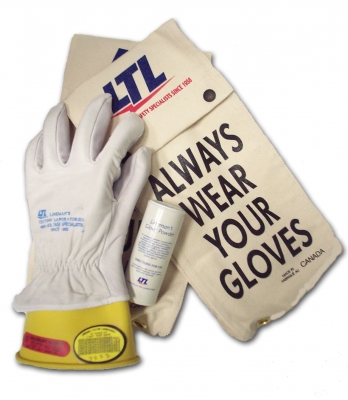LTL Blog
Lineman's Testing Laboratories of Canada
Ensuring Electrical Sa...
Ensuring the Integrity...
Tips for safety when w...
7 Benefits to Using Gr...

Did you know that when there is damage to your electrical insulating rubber gloves, the integrity of your gloves are compromised? This means that they are no longer safe to use.
As Canada’s largest stocking supplier of insulating rubber gloves and PPE, one question we are frequently asked about is the proper care, maintenance, and storage of electrical insulating rubber gloves.
Follow these 6 simple steps to help prolong the life of your gloves and maintain the highest level of insulating protection for your safety:
1: Remember to always visually inspect insulating rubber gloves (inside & out) for damage before each use. DO NOT USE defective or suspected defective gloves -- gloves that show signs of cuts, severe scratches, holes, cracks, burns, ozone cutting/checking, contamination from foreign matter, swelling, or loss of normal elasticity. Should any of these conditions exist, discontinue use and send to LTL, a NAIL accredited certified testing facility for further evaluation
2: When preparing to clean your electrical insulating gloves, remove all jewelry and sharp objects from your arms to prevent possible damage to the gloves
3: Clean your gloves in a mild detergent and controlled water temperature (warm water). Only use soapy water or denatured alcohol to clean label area
4: Air dry or dry electrical gloves with a clean, soft cloth
5: Take rubber gloves, put gloves on top of each other and place in a clean glove bag – ensure gloves are not folded, bent or creased
.jpg)
6: Store your dry electrical insulating rubber gloves in a protective bag in a cool, dark, and dry location. Ensure the area is free from ozone, chemicals, oils, solvents, damaging vapours or fumes, and away from electrical discharges and sunlight
DO NOT STORE gloves folded, creased, inside out, compressed, or in any manner which may cause stretching or compression. Remember, for maximum personal protection, it is essential that gloves are properly cared for, stored, inspected and electrically tested by an accredited certified laboratory on a regular basis per legislated standards and/or company policy.
LTL also recommends wearing leather protectors on top of your electrical insulating rubber gloves for mechanical protection against cuts, abrasions and punctures.
To learn more on properly maintaining your PPE, watch our videos or visit our website at www.ltl.ca for our product and service offerings. If you have any questions, please call your local LTL Product Specialist.
Your comment will go through an approval process and may not be visible to the public right away.


